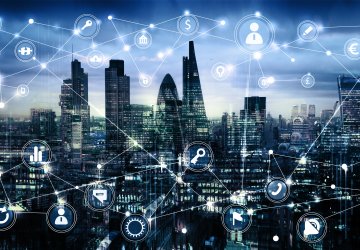
At bGrid – sensor partner of Planon – we believe that the potential of building data is so immense that capabilities are often far beyond what was initially imagined. Take for instance the smart phone. When first created by its inventors, its true future potential was unknown. Every forward-thinking building owner should be embracing the concept of smart buildings. It means creating adaptable and flexible solutions that can easily evolve to benefit future generations. But, how can you achieve this?
Be flexible to adapt
The answer is quite simple - be flexible. Adaptability is everything. Investing in a smart building solution which has an open API to enable third party hardware and software to connect allows your office to be future-proof. With this smart building technology, you are free to select your own applications best suited to your particular needs. Other systems and applications can easily connect to smart building solutions that have this flexibility, openness, and adaptability. This is what you need to grow over time, to embark on a continuous process of change to better understand what is going on in the building, and how you can match this better to the needs of the users. And as new software innovations and smart building applications evolve, so does the building.
Diverse smart building benefits
It is possible for every organization to get significant benefits from investing in an ever-evolving smart building. Gathering custom building data such as measurements of CO2 levels as well as VOC (Volatile Organic Compounds), for example, provides more layers of information on the air quality levels that building occupants are breathing in on a daily basis. If organizations want to go back to their workforce spending approximately 90% of their time indoors with an average working week of 40 hours, it is important to get comfort and cleanliness levels right first time, to ensure the optimal healthy working environment.
Secondly, gathering data on how many occupants are using a building, in particular meeting rooms, is important when monitoring and maintaining a healthy workplace. Smart Building Management Systems gather data on building utilization and feed that back to facility managers to show how certain parts of their building are performing. For instance, in measuring meeting duration and number of attendees, overcrowding can be detected quickly. Patterns and trends can also be evaluated from historic data gathered from a building over time. This helps identify the flow of occupants through a building and can highlight problems such as overcrowding, thus helping teams to collaborate efficiently within healthy surroundings. Here the building can evolve with an organization and its ways of working.
The importance of healthy buildings “Now”
In recent months, knowing the status of our building’s indoor climate health has become more critical than ever before. With the global pandemic of COVID-19, measuring indoor climate, especially air quality, and preventing overcrowding has become a high priority for building owners, employers and workplace occupants. Adaptive smart building solutions are what is needed to act quickly and gather relevant building data on the indoor environment such as CO2, humidity and workplace occupancy levels. The building’s hardware needs to allow you to unlock the relevant data effectively, and process this in an application, selected by you. This should be linked as closely as possible to your primary process, so that your building can adapt to the changes in the needs from your working environment, often influenced by external changes beyond your organization’s control.
bGrid solutions to support new COVID-19 measures
Advanced with AI and machine learning, bGrid’s smart building solution gathers data from building occupants via multi-sensors and turns it into valuable and actionable insights for building owners and facility managers. For example, it combines measurements of not only building occupancy but also CO2 and humidity levels. These insights can help owners, operators and occupiers to adhere to physical distancing and ensure safe air quality. This is one example of how we can adapt to our client needs in the effort to help combat the spread of COVID-19 in the workplace.
COVID-19 has changed the whole world around us – but at bGrid we innovate through change. We see changes as wake-up calls to challenge our ways of working. Our customers are also a great inspiration by constantly challenging us. So how are you preparing to return your employees to the office? How can you best tackle new ways of working in your organization? Contact us to discuss how the latest in smart building solutions can be implemented.
Our partnership with Planon
bGrid and Planon have partnered to combine strengths and to unlock the greater potential of smart buildings. Planon’s current software connectors for Workspace-, Room- and Area sensors are compatible with our bGrid multi-sensors. bGrid’s flexible smart building solution and open API combined with Planon’s software solutions for Space and Workplace Management have expanded the possibilities for smart buildings. bGrid measures building data from building utilisation to CO2 and VOC levels. Based on these measures, Planon provides sharper insights for end users in terms of room booking, predictive maintenance, smart cleaning, personal comfort control and energy efficiency measurement.
Do you want to know more about how the advantages of open software for your real estate and facilities management organization? Read Planon’s white paper “Point solutions or an integrated solution: why choose?”





















